Do you have a question about the Triumph Tiger XRT and is the answer not in the manual?
Covers general safety aspects related to the motorcycle's design and intended use.
Provides critical warnings about handling flammable gasoline and the dangers of exhaust fumes.
Emphasizes the importance of wearing appropriate protective gear for rider safety.
Explains the TSAS warning light modes, calibration, and fault indicators.
Allows configuration of different motorcycle features like TSAS, ABS, and TC.
Explains automatic reset functionality for trip meters after ignition is switched off for a set time.
Shows the current riding mode and details on accessing riding mode information.
Details the features and operation of the TFT digital instrument display.
Explains the TC settings for different riding modes, including warnings for improper use.
Explains the TC indicator light and its operation for indicating system activity.
Explains how warning and information messages are shown in the Warnings tray.
Describes the TSAS information tray item for adjusting front and rear suspension damping settings.
Explains how to enable or disable the hill hold control system for assisting hill starts.
Explains how to reset main menu items to their default factory settings.
Details how to adjust the instrument panel position for improved visibility and safety.
Warns about the consequences of disabling traction control and its potential impact on handling.
Explains the process of configuring a specific riding mode via the settings menu.
Describes the menu for configuring riding modes, including available options.
Details how to enable or disable Triumph Shift Assist, which aids gear engagement.
Details how to manually reset trip meters, including reset options.
Lists potential warning messages displayed if a fault is detected.
Describes the initial illumination of warning lights and those remaining on until the engine starts.
Details the low fuel warning light and the action required when it illuminates.
Introduces the riding modes system for adjusting throttle response, ABS, and TC settings.
Explains the high coolant temperature warning light and the caution to stop the engine immediately.
Details how to change the ABS setting and warnings regarding disabling the system.
Details the function and meaning of the MIL warning light for engine management system faults.
Explains the low oil pressure warning light and the caution to stop the engine immediately.
Details how to select riding modes and the conditions required for selection.
Describes the immobilizer indicator light behavior with and without an alarm system.
Describes the battery warning light behavior and when it illuminates due to low battery voltage.
Details how to change the TC (traction control) setting and warnings regarding disabling it.
Explains the TPMS warning light and its conditions for illuminating.
Describes the normal and fault behavior of the ABS warning light, including system disabled messages.
Explains the TPMS warning light, its illumination conditions, and necessary actions.
Provides a table detailing ABS, MAP, and TC options available for each riding mode.
Details how to enable or disable the ABS system, noting it cannot be permanently disabled.
Details how to enable or disable the ABS system, noting it cannot be permanently disabled.
Explains how to enable or disable the Traction Control (TC) system.
Explains how to enable or disable the Traction Control (TC) system.
Describes the ABS settings for different riding modes, including warnings for improper use.
Details the actions required when selecting a riding mode while the motorcycle is in motion.
Explains the keyless ignition system, allowing starting without a mechanical key.
Provides critical safety instructions for refueling to prevent hazards.
Provides warnings about cruise control usage, speed limits, and conditions to avoid.
Explains the steps and conditions required to activate the cruise control system.
Explains the TC system's function in maintaining traction and warnings about its limitations.
Details the optimized cornering TC system designed for increased control during cornering.
Emphasizes operating only within legal speed limits and in authorized conditions.
Details how to adjust the set speed while cruise control is active using RES/+ and SET/- buttons.
Explains how to resume the set speed using the RES/+ button, provided conditions are met.
Describes the TSAS system, its modes, damping settings, and system calibration.
Explains the operation of heated seats, including switches and symbols.
Describes the methods for deactivating cruise control, such as rolling off the throttle or pulling the clutch.
Provides warnings about low tire pressure and the necessary actions.
Lists essential daily checks required for safe and reliable motorcycle operation.
Details the procedure for stopping the engine, including cautions about the engine stop switch.
Details the steps required to start the motorcycle's engine, including safety precautions.
Provides warnings about braking techniques, including downshifting and brake application.
Describes the ABS warning light behavior and when it indicates a malfunction or is disabled.
Explains the hill hold control system, its activation, and warnings about slippery surfaces.
Offers advice on emergency braking and practicing the technique safely.
Explains the braking system, including front and rear brake operation.
Explains how ABS helps prevent wheel locking and provides warnings about its limitations.
Details the optimized cornering ABS system for increased control during cornering.
Discusses factors affecting motorcycle stability and handling at high speeds.
Provides warnings about parking safely, considering flammable materials and hot engine parts.
Warns about exceeding pannier and top box load limits, and storing items between frame and tank.
Warns about the risks of incorrect loading, emphasizing distribution and security.
Provides guidance on breaking-in new brake discs and pads for optimal performance.
Warns about brake fluid's hygroscopic nature and the need for regular replacement.
Details how to inspect and adjust the front brake fluid level.
Warns about the dangers of incorrect tire inflation and emphasizes checking pressures when cold.
Warns that punctured tires must be replaced to avoid instability and loss of control.
Details the procedure for installing the battery, including terminal connection and terminal protection.
Explains the TPMS function, its display, and when owners should adjust tire pressures.
Details clutch fluid inspection and adjustment, emphasizing DOT 4 fluid use.
Emphasizes using approved tires and combinations for safety and performance.
Explains how to adjust the spring preload on the rear suspension unit.
Advises inspecting tires for damage, especially after impacts, and consulting a dealer.
Emphasizes the importance of scheduled maintenance and warns against incorrect procedures.
Provides a detailed table outlining maintenance tasks based on mileage or time intervals.
Covers engine oil specifications and maintenance requirements.
Covers brake system inspection, maintenance, and fluid requirements.
Provides instructions for changing the engine oil and oil filter.
Provides warnings about battery handling, explosive gases, and corrosive acid.
Provides warnings about battery charging, including dangers of gases and using correct chargers.
Details how to inspect the engine oil level using the sight glass.
Details how to inspect brake pads for wear and when replacement is necessary.
Warns about explosive battery gases and the need for ventilation and spark prevention.
Details how to inspect and adjust the rear brake fluid level.
Details the procedure for removing the battery, including safety precautions.
Stresses the importance of accurate wheel balance for safe handling.
Lists approved tire specific to models and warns about mixing manufacturers or specifications.
Specifies the maximum payload capacity for different Tiger 1200 models.
Provides tire specifications including pressures, sizes, and wear limits.
Covers general safety aspects related to the motorcycle's design and intended use.
Provides critical warnings about handling flammable gasoline and the dangers of exhaust fumes.
Emphasizes the importance of wearing appropriate protective gear for rider safety.
Explains the TSAS warning light modes, calibration, and fault indicators.
Allows configuration of different motorcycle features like TSAS, ABS, and TC.
Explains automatic reset functionality for trip meters after ignition is switched off for a set time.
Shows the current riding mode and details on accessing riding mode information.
Details the features and operation of the TFT digital instrument display.
Explains the TC settings for different riding modes, including warnings for improper use.
Explains the TC indicator light and its operation for indicating system activity.
Explains how warning and information messages are shown in the Warnings tray.
Describes the TSAS information tray item for adjusting front and rear suspension damping settings.
Explains how to enable or disable the hill hold control system for assisting hill starts.
Explains how to reset main menu items to their default factory settings.
Details how to adjust the instrument panel position for improved visibility and safety.
Warns about the consequences of disabling traction control and its potential impact on handling.
Explains the process of configuring a specific riding mode via the settings menu.
Describes the menu for configuring riding modes, including available options.
Details how to enable or disable Triumph Shift Assist, which aids gear engagement.
Details how to manually reset trip meters, including reset options.
Lists potential warning messages displayed if a fault is detected.
Describes the initial illumination of warning lights and those remaining on until the engine starts.
Details the low fuel warning light and the action required when it illuminates.
Introduces the riding modes system for adjusting throttle response, ABS, and TC settings.
Explains the high coolant temperature warning light and the caution to stop the engine immediately.
Details how to change the ABS setting and warnings regarding disabling the system.
Details the function and meaning of the MIL warning light for engine management system faults.
Explains the low oil pressure warning light and the caution to stop the engine immediately.
Details how to select riding modes and the conditions required for selection.
Describes the immobilizer indicator light behavior with and without an alarm system.
Describes the battery warning light behavior and when it illuminates due to low battery voltage.
Details how to change the TC (traction control) setting and warnings regarding disabling it.
Explains the TPMS warning light and its conditions for illuminating.
Describes the normal and fault behavior of the ABS warning light, including system disabled messages.
Explains the TPMS warning light, its illumination conditions, and necessary actions.
Provides a table detailing ABS, MAP, and TC options available for each riding mode.
Details how to enable or disable the ABS system, noting it cannot be permanently disabled.
Details how to enable or disable the ABS system, noting it cannot be permanently disabled.
Explains how to enable or disable the Traction Control (TC) system.
Explains how to enable or disable the Traction Control (TC) system.
Describes the ABS settings for different riding modes, including warnings for improper use.
Details the actions required when selecting a riding mode while the motorcycle is in motion.
Explains the keyless ignition system, allowing starting without a mechanical key.
Provides critical safety instructions for refueling to prevent hazards.
Provides warnings about cruise control usage, speed limits, and conditions to avoid.
Explains the steps and conditions required to activate the cruise control system.
Explains the TC system's function in maintaining traction and warnings about its limitations.
Details the optimized cornering TC system designed for increased control during cornering.
Emphasizes operating only within legal speed limits and in authorized conditions.
Details how to adjust the set speed while cruise control is active using RES/+ and SET/- buttons.
Explains how to resume the set speed using the RES/+ button, provided conditions are met.
Describes the TSAS system, its modes, damping settings, and system calibration.
Explains the operation of heated seats, including switches and symbols.
Describes the methods for deactivating cruise control, such as rolling off the throttle or pulling the clutch.
Provides warnings about low tire pressure and the necessary actions.
Lists essential daily checks required for safe and reliable motorcycle operation.
Details the procedure for stopping the engine, including cautions about the engine stop switch.
Details the steps required to start the motorcycle's engine, including safety precautions.
Provides warnings about braking techniques, including downshifting and brake application.
Describes the ABS warning light behavior and when it indicates a malfunction or is disabled.
Explains the hill hold control system, its activation, and warnings about slippery surfaces.
Offers advice on emergency braking and practicing the technique safely.
Explains the braking system, including front and rear brake operation.
Explains how ABS helps prevent wheel locking and provides warnings about its limitations.
Details the optimized cornering ABS system for increased control during cornering.
Discusses factors affecting motorcycle stability and handling at high speeds.
Provides warnings about parking safely, considering flammable materials and hot engine parts.
Warns about exceeding pannier and top box load limits, and storing items between frame and tank.
Warns about the risks of incorrect loading, emphasizing distribution and security.
Provides guidance on breaking-in new brake discs and pads for optimal performance.
Warns about brake fluid's hygroscopic nature and the need for regular replacement.
Details how to inspect and adjust the front brake fluid level.
Warns about the dangers of incorrect tire inflation and emphasizes checking pressures when cold.
Warns that punctured tires must be replaced to avoid instability and loss of control.
Details the procedure for installing the battery, including terminal connection and terminal protection.
Explains the TPMS function, its display, and when owners should adjust tire pressures.
Details clutch fluid inspection and adjustment, emphasizing DOT 4 fluid use.
Emphasizes using approved tires and combinations for safety and performance.
Explains how to adjust the spring preload on the rear suspension unit.
Advises inspecting tires for damage, especially after impacts, and consulting a dealer.
Emphasizes the importance of scheduled maintenance and warns against incorrect procedures.
Provides a detailed table outlining maintenance tasks based on mileage or time intervals.
Covers engine oil specifications and maintenance requirements.
Covers brake system inspection, maintenance, and fluid requirements.
Provides instructions for changing the engine oil and oil filter.
Provides warnings about battery handling, explosive gases, and corrosive acid.
Provides warnings about battery charging, including dangers of gases and using correct chargers.
Details how to inspect the engine oil level using the sight glass.
Details how to inspect brake pads for wear and when replacement is necessary.
Warns about explosive battery gases and the need for ventilation and spark prevention.
Details how to inspect and adjust the rear brake fluid level.
Details the procedure for removing the battery, including safety precautions.
Stresses the importance of accurate wheel balance for safe handling.
Lists approved tire specific to models and warns about mixing manufacturers or specifications.
Specifies the maximum payload capacity for different Tiger 1200 models.
Provides tire specifications including pressures, sizes, and wear limits.
| Engine Type | Liquid-cooled, 12 valve, DOHC, in-line 3-cylinder |
|---|---|
| Transmission | 6-speed |
| Fuel System | Multipoint sequential electronic fuel injection |
| Final Drive | O-ring chain |
| Frame | Tubular steel trellis frame |
| Wheels | Cast aluminium alloy |
| Power | 70 kW |
| Fuel Capacity | 20 L (5.28 US gal) |
| Wet Weight | 221 kg |
| Rear Suspension | Showa monoshock, adjustable rebound and compression damping |
| Front Brakes | Twin 305 mm floating discs |
| Rear Brakes | Single 255 mm disc |
| Tires (Front) | 120/70 |
| Tires (Rear) | 170/60 R17 |
| Electronics | Traction control, ABS, Cruise control, Heated grips |

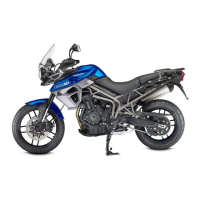
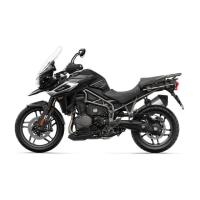
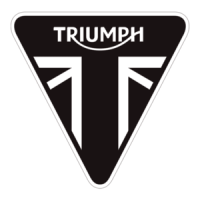


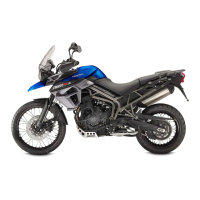
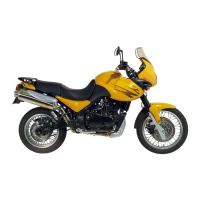
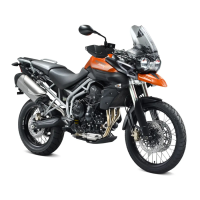
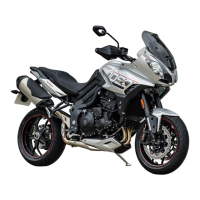
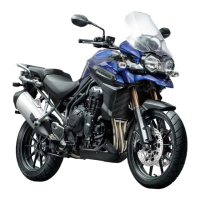
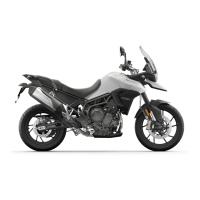
